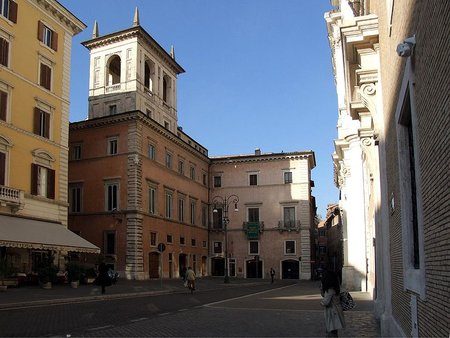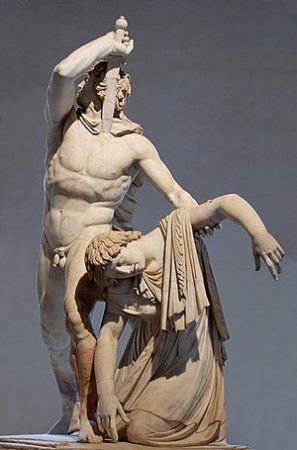Just the exteriors and the façade of the magnificently designed Palazzo Altemps is guaranteed to steal your attention. And then there is the fact that it is National Roman Museum’s best known branch. The Palazzo which is actually a 15th century palace that stands on the ruins of a 12th century house lies around the corner from Piazza Navona.
In 1568, a German cardinal who had a special interest for ancient sculpture brought it and that’s actually how the collection was born. Many of the items from this museum were sent off to more illustrious counterparts like the Louvre though what remains inside is still jaw dropping.

History
Even back in the 15th century the Altemps Palace was one of the more beautiful examples of Renaissance architecture. The building was designed by Melozzo da Forli and commissioned by Girolamo Riario (incidentally a relative of Pope Sixtus IV) in 1477 and it stood in an area that dealt with the administration of royal marble. This was the hugest marble warehouses in the old city just 160 metres up from the Tiber from the Ponte Elio.
The phase during which the Palazzo Altemps was constructed was the great urbanisation phase of Campus Martius following the re arrival of the Papacy. Incidentally the Radio family were big on building impressive buildings….the Cancellaria and Palazzo Corsini are also created by them.
There was probably an Apollo temple nearby as the fragments of the temple were discovered at the time of excavation. The Riario family which earlier had a lot of influence on Roman politics fell to disrepute after the death of Pope Sixtus IV and then the palazzo was sold off to Cardinal Francesco Soderini of Volterra.
Later the Austrian original Cardinal Mark Sittich Atteps (nephew of Pope Sixtus) bought it and Martino Longhi expanded the palazzo and built the lovely belvedere. The Altemps family mixed a lot in the Italian Noble circles. The Cardinal Mark Altemps had an extensive art collection that included priceless statues and he wanted to revamp the Palazzo completely to befit his collections and positions. During the renovations the courtyard, church of Ancietus, Loggia (as seen now) were built.
In 1724 the cardinal Melchior de Polignac made the Palazzo Altemps their headquarters and in those days dance parties and musical performances by masters like Mozart were common there. It is said that the courtyard fountain used to sprout wine in those times.
The Holy See acquired the property in the 19th century and it functioned as a seminary for a short period of time. The property was granted to the Italian state in 1982 and then underwent a 15 year long restoration.
Since 1997 the palazzo Altemps opened to the public and has been one of the 4 seats of the National Roman Museum. The focus in this branch of National Roman Museum is on Baroque and Renaissance archaeological collections unearthed in Rome.
Besides the iconic Ludovisi collection (sculptures bought by Ludovico Ludovisi, a nephew of Pope Gregory XV); the Boncompagni collection, the Asdrubale 16th century collection and the Ciriaco Mattei collection along with the Altemps collection are all housed inside this palace.
What To See & Do
You will notice the elegant building standing on Piazza Navona from a distance; it has a grand courtyard, beautifully painted loggia and many frescoed rooms. The building itself is L shaped and you can notice three different window styles from outside. The first floor has simple corniced style, the second has architraves windows with balconies while the third has architraves windows minus balconies. Notice the cornice and trusses that sits on the Palazzo Altemps like a crown. The face of the building that looks upon Via S Apollinare has the main entrance and this will lead to the principal courtyard.
Appreciate that the Palazzo Altemps was created in antique times to provide the perfect setting for beautiful works of art. The marble used inside and the colour scheme all complemented the artwork excellently. There are 2 floors comprising of a succession of beautiful rooms, chairs and a maze of corridors apart from a church. Take your time (at least 3 hours) to see the entire collection or only breeze through the most important exhibits (1 hour).
Courtyard
As you enter the museum you will go through the lovely courtyard that has frescoes and arcades that open up on the entrances ….the Orsini and Altemps crests flash everywhere. The inner smaller courtyard has a lovely mosaic fountain. Carefully look at the Altemps coat of arms or a bridge being struck by lightning. This is a place to relax and contemplate and it’s difficult to imagine that it’s near the bustling piazza Navona.
Collections & Sections
The Hall of Portraits contains the busts of Caesars. Also noteworthy are the busts of different personalities like Hostilian, Aristotle, emperor Antoninus Pius, Zeus, Princess Julia, daughter of emperor Augustus etc.
Hall of Towers is a good place to check out the 12th century tower of the house that lies submerged under the Altemps palace. The Hall of Entrance to Palazzo Riario has the famous sculpture ‘Aphrodite after bathing’. Hall of Athena has many statues of the Goddess.
The Palace dining room has mosaics and frescoes brought in from the Villa of Livia and the Villa of Farnesina…all reconstructed to match original dimensions.
Boncompagni Ludovisi collection comprises of around 104 statues that the Italian government purchased from the Ludovisi Compagni family in 1900. You won’t probably have the energy to go through all of them so the stars of the Ludovisi collection are as follows…
The 5th century Trono Ludovisi / Ludovisi Throne is one of the star exhibits. It’s an intricately carved marble block that has a central relief showing Venus delicately plucked from the sea.
Ares Ludovisi is an exceptional sculpture that dates back to the 2nd BC. In this a young and well groomed Mars is shown in action. Ludovisi Pluto is a beautiful demonstration of the God. The ludovisi Hera stands here….she is actually an idealised portrait of Antonia Augusta who was the mother of Emperor Claudius.
Another very famous sculpture is the Ludovisi Gaul that has the plaque subtitled into it ‘Gaul killing himself and his wife’. If you have been to the Capitoline museums and have seen the saying Gaul then you might recognise that this statue is a part of the same grouping. Art evaluators say that the one in Altemps is a copy that was commissioned by Julius Caesar himself for his Quirinal estate. You will find this statue in room 26.

These pieces are all a part of the famous Ludovisi collection that once stood in the magnificent villa gardens of Via Vittorio Veneto.
Right besides room 26 is the Fireplace Salon that has a magnificent fireplace bearing caryatids and ibex; both of which are symbols of the Altemps family. The Grand Ludovisi Sarcophagus sits here…it dates back to the 3rd century and it was originally discovered near the Porta Tiburtina in 1621. The pair in the middle that is the Roman soldier and the barbarian he is about to kill have tremendous expressions
Mattei Collection is housed inside the galleries on the sides of the courtyard. The first floor has a room that holds ancient sculpture that originally decorated the gardens and the villa of Ciriaco Mattei on the Hill Caelian. Look out for the antique yellow marble statue ‘Dacian’.
Drago Collection is housed in the southern loggia which has 4 bas reliefs that dates back to the 2nd century. The relief shows the Gods sporting on Mount Olympus. Room of the Painted Views is full of lovely tapestries and frescoes.
The cardinal Altemps bedchamber has a beautiful wooden ceiling and a stunning sculpture of Dionysus.
Notice the Sala delle Prospettive Dipinte that’s decorated with hunting scenes for Cardinal Altemps (the wildly rich nephew of Pope Pius IV) along with some marvellous landscapes. Incidentally Cardinal Altemps was one of the subsequent owners of the palace and that’s how it got its name.
If you are interested in Egyptian art then go straight to the apartments of D’Annunzio that has Egyptian and Syrian pieces. These were excavated from Roma in the area of the grand Campus Martius where the large sanctuary stood. There is a separate room dedicated to Mother Goddess whose most interesting exhibit is the head of Ephesian Artemis (excavated in 2009 from Via Marmorata).
Don’t miss the small but lovely church of Anicetus that’s dedicated both to St Anicetus and Mother Mary. Though this is small enough to be called a shrine the papacy gave it the status of a church since it houses the remains/ tomb of a saint Pope (Anicetus who was the only pope to be buried in a private chapel). This erstwhile Private Chapel that has an ethereal ceiling fresco that consists of blooming cherubs.
The rooftop terrace though often overlooked is elegant and has obelisks plus a statue of an ibex that’s the symbol of Altemps. Notice the 4 pyramidal spires that surmount the terrace….the whole concept was created by Martino Longhi the elder.
Don’t miss a look at the recently restored Goldoni Theatre (a tribute to the famous playwright’s intimate connection to the Palazzo). It now functions as a conference centre. Often exhibitions of modern art, archaeology and music are held in the Palazzo Altemps.
Note:
While looking at the sculptures remember that many of them were modified in renaissance/ baroque times. The pommel and grip of the Ludovisi Ares was for example created by Bernini and one of the legs of the Mars Statue was also modified by him. Unlike many other museums which categorically removes the refurbishments to the statues before displaying them, the National Roman Museums have honoured the renaissance collectors by displaying the sculpture as they would have wanted it to. However detailed and clear explanatory signs flank the statues and one can easily understand which parts are ancient and which are not.
While checking out all the sculptures don’t miss looking at the interiors which are an excellent example of Roman multi-layered design. Some ceilings in particular have 16th century grotesques appearing behind 17th century battle scene frescoes and 15th century decorations flanking all of it. Another part of the museum has its excavation unearth the remains of a 12th century tower that lied behind the ground floor of the museum. Later it was discovered that the Palazzo Altemps stands on the crumbles of a 12th century house. Palazzo Altemps is as much visit worthy for its lovely sculpture as its wonderful structure and real estate aesthetics.
Location & Hours
The Palazzo Altemps is just one block northwest of Piazza Navona. You will find that the bus numbers 70, 81, 87, 116T, 186, 492, 628 are convenient for getting to the location.
Piazza di Sant’Apollinare, 46. Phone: +39.06.39967700. Website
Call between Monday – Saturday 9.00 a.m. – 1.30 p.m. and 14.30 p.m. – 17.00 p.m. for group bookings.
Open every day from 9.00 to 19.45. The palazzo Altemps remains closed on Mondays.
For ticketing information, refer to National Roman Museum.
The Pantheon and the Castel Sant Angelo are both under 1 km away from the museum Altemps so you can easily walk to these once you are done checking out the palazzo.
 A travel addict. Still celebrating the day when he quit his high-profile corporate job to pursue his passion for travel writing.
A travel addict. Still celebrating the day when he quit his high-profile corporate job to pursue his passion for travel writing.